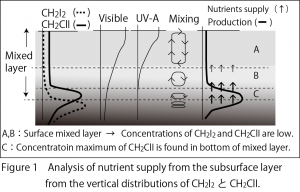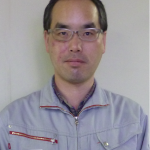Atsushi Ooki
Structure of surface mixed layer analyzed by temporal change of vertical distribution of photodegradable organic iodine gases
Research summary
The purpose of this study is to analyze the formation history of surface mixed layer in the ocean from temporal changes of vertical distributions of photodegradable organic iodine gases, and the primary production maintained by nutrient supply from the subsurface layer.
Biogenic volatile organic gases are dissolved in seawater. Volatile organic iodine compounds (VOIs) photodegrade in the surface mixed layer and the subsurface layer of the ocean. Diiodomethane (CH2I2) photolyzes with visible (blue) and ultra violet (UV-A) rays, and chloroiodomethane (CH2ClI) photolyzes with ultra violet ray (UV-A). Vertical distribution of diiodomethane shows extremely low concentration in the surface mixed layer and just below the mixed layer, and that of chloroiodomethane shows moderately low concentration in the surface mixed layer. The depth of concentration maximum of chloroiodomethane is several meters shallower than that of diiodomethane. These vertical distributions are determined by photolysis of the compounds and the structure of vertical mixing. It is expected that the mixing structure can be analyzed from the vertical distributions of these photodegradable VOIs and sunlight spectrum in the ocean (Figure 1). Shipboard observations are planned in the subarctic gyre of the North Pacific in 2016 and 2017, and in the coastal water of the Funka-Bay, Hokkaido, every month in 2016 and 2017.
Principal Investigator:
Atsushi Ooki
Faculty of Fisheries Sciences, Hokkaido University
http://hokusui-ocean-biogeochemistry.jimdo.com/
Daiki Nomura
Fisheries sciences, Hokkaido University




